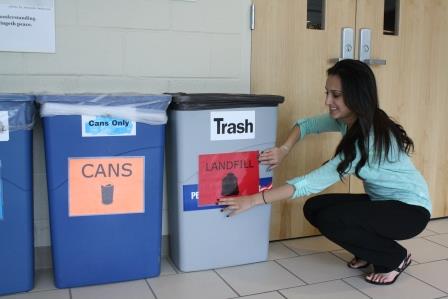
DUBOIS – Some students at Penn State DuBois have helped to clean up campus where recycling and environmental efforts are concerned, all while gaining valuable real-world experience to bolster their education.
Students in Marketing 342 offered their services to create marketing plans for their class projects recently, and the campus Green Team took them up on that offer.
The challenge was to create a marketing plan that would help to increase the rate of recycling on campus. Specifically, members of the Green Team who lead green and sustainable initiatives on campus were interested in promoting the use of recycling bins.
The bins have been available on campus for several years, offering separate receptacles for plastic, paper, aluminum, glass and trash. However, Green Team members realized that the bins were heavily contaminated with general trash, making it impossible to recycle the content of the bins.
“If it’s too high in contamination, they have to put it all in the trash. It cannot be recycled.” explained Green Team member Mary Walker.
She noted that an increase in recycling efforts is not only good for the environment, but also a cost saver for the campus. “It’s $70 per ton for trash disposal. Recyclables, like mixed paper, are $20 per ton to dispose of.”
After deciding that awareness may be a factor in the lack of recycling bin use, Walker approached Assistant Professor of Economics Evelyn Wamboye about assigning her marketing students to develop a way to raise awareness of the bins. It gave the students a chance to interact with the Green Team, as they would with a client, and cultivate something that would meet the client’s needs.
Wamboye said, “I challenge my students to identify and define market-driven opportunities and problems, design methods for collecting information, manage the information collection process, analyze and interpret the results, and communicate the findings to their client.
“My goal is to push them beyond their comfort zones and teach them to be co-creators of knowledge by thinking outside the box. When students graduate, they realize that life is not that simple and structured and we have to prepare them in a way that mirrors what is out there.”
This project achieved Wamboye’s goals. Students started by performing trash audits, in which they got their hands dirty digging through campus recycling bins and calculating the amount of contamination there was in each bin.
They found the average rate of contamination was 35 percent. They also gathered data by sending out a survey to students that asked about their awareness and use of recycling receptacles. Their research revealed that, indeed, awareness could be increased.
Students then then set about the task of advertising the bins. They designed new, bright, color-coded signs for each type of bin. They then spread the word through on-campus marketing, such as posting announcements on digital displays around campus and distributing flyers.
Within the semester, they saw results. During a second trash audit they found that the rate of contamination in the recycling bins had dropped from the previous 35 percent, to 5 percent.
“The objective was to reduce contamination and increase awareness,” Walker said. “It worked, and it really changed the attitudes of our students. The marketing students created tools that we are now using to promote this initiative, and we will continue to use them in the future.”
Student Rima Shah, a marketing and management major, worked on the project. She said developing the plan and carrying it to the end provided valuable lessons for her, as she looks ahead to a career in marketing and business.
“We learned so much about the process of marketing,” Shah said. “We learned about research, identifying a target audience, breaking it all down and implementing a plan. That’s something businesses do with their marketing all the time. We also saw the results. We saw that we can save the campus money and raise awareness.”